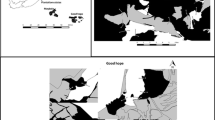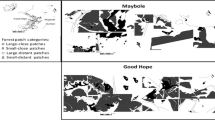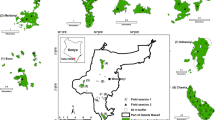Abstract
Historically, where forest habitats are deemed as the pristine landscape state, anthropogenic habitats such as managed grasslands or open spaces are often perceived to be antagonistic and of secondary conservation priority. Traditionally, studies on biodiversity responses to ecological variation, i.e. edge effect, have mostly focused on forest habitats. Yet recently there has been increased attention on communities beyond the forest edge in an effort to better understand how interactions between forests and adjacent habitats may potentially affect regional biodiversity. However, in Europe and the Mediterranean basin (a biodiversity hotspot), areas with high landscape heterogeneity and high edge density, there is a paucity of studies analysing the community responses across forest and “beyond edge” habitats across ecotones. In a protected area of central Italy, we investigated the responses of ground-dwelling arthropods [Araneae (spiders), Chilopoda (centipedes) and Carabidae (ground beetles)], which were differentiated into habitat-specific guilds (forest, edge and grassland species) across a forest–grassland ecotone. We investigated the extent to which a habitat edge influenced communities of arthropods associated with either the forest or grassland, and how far from the edge this effect penetrated into each habitat. Twelve 150 m-transects perpendicular to a forest–grassland edge were established and arthropods were sampled at nine progressive distances across the ecotone. An indicator species analysis was used to detect species significantly associated with forest, edge-belt or grassland habitats, which were assumed representative of the respective communities. Logistic models of indicator species richness and abundances were used to describe responses of grassland and forest communities across the ecological boundaries. We found that grassland and edge habitats had habitat specialists and higher species richness compared to the forest habitat. Moreover, the occurrence of grassland-specific species was influenced by the presence of an edge up to 15 m from the habitat border. In contrast forest-associated indicator species were not affected by proximity to the habitat edge, rather individuals typical of forest habitats tended to “spill over” into grassland habitats. These findings support the hypothesis that in a forest–grassland mosaic, forest species are less sensitive to an edge and influence the community beyond the forest edge and into the grassland more than the reverse, i.e. the effect was asymmetric. From these data, we estimated that a minimum grassland habitat width of 600 m is necessary for grassland species to maintain a core area that is relatively unaffected by the spillover of species from adjacent forest habitats. Incorporating the directional influences of adjacent communities on each other allows for an empirical assessment of habitat vulnerability that doesn’t a priori value the conservation of one habitat over another.





Similar content being viewed by others
References
Anderson MJ (2001) A new method for non-parametric multivariate analysis of variance. Aust Ecol 26:32–46
Andres C, Ojeda F (2002) Effects of afforestation with pines on woody plant diversity of Mediterranean heathlands in southern Spain. Biodivers Conserv 11:1511–1520
Attorre F, De Sanctis M, Francesconi F, Scarnati L, Scepi E, Bruno F (2005) Sistema Informativo della Natura del Lazio. Piani di gestione e tematismi ambientali in aree protette Monti Simbruini, Monti Lucretili, Monte Rufeno e Marturanum. ARP- Agenzia Regionale Parchi
Baker SC, Barmuta LA (2006) Evaluating spatial autocorrelation and depletion in pitfall-trap studies of environmental gradients. J Insect Conserv 10:269–276
Barlow J et al (2007) Quantifying the biodiversity value of tropical primary, secondary, and plantation forests. PNAS 104:18555–18560
Bengtsson J, Nilsson S-G, Franc A, Menozzi P (2000) Biodiversity, disturbances, ecosystem processes and sustainability of European forests. For Ecol Manag 132:39–50
Bieringer G, Zulka KP (2003) Shading out species richness: edge effect of a pine plantation on the Orthoptera (Tettigoniidae and Acrididae) assemblage of an adjacent dry grassland. Biodivers Conserv 12:1481–1495
Bieringer G, Zulka KP, Milasowszky N, Sauberer N (2013) Edge effect of a pine plantation reduces dry grassland invertebrate species richness. Biodivers Conserv 22:2269–2283
Bond WJ, Parr CL (2010) Beyond the forest edge: ecology, diversity and conservation of the grassy biomes. Biol Conserv 143:2395–2404
Bond WJ, Silander JA, Ranaivonasy J, Ratsirarson J (2008) The antiquity of Madagascar’s grasslands and the rise of C4 grassy biomes. J Biogeogr 35:1743–1758
Bremer LL, Farley KA (2010) Does plantation forestry restore biodiversity or create green deserts? A synthesis of the effects of land-use transitions on plant species richness. Biodivers Conserv 19:3893–3915
Cadenasso ML, Pickett STA (2001) Effect of edge structure on the flux of species into forest interiors. Conserv Biol 15:91–97
Cadenasso ML, Traynor MM, Pickett STA (1997) Functional location of forest edges: gradients of multiple physical factors. Can J For Res 27:774–782
Cadenasso ML, Pickett ST, Weathers KC, Jones CG (2003) A framework for a theory of ecological boundaries. Bioscience 53:750–758
Cardoso P, Aranda SC, Lobo JM, Dinis F, Gaspar C, Borges PAV (2009) A spatial scale assessment of habitat effects on arthropod communities of an oceanic Island. Acta Oecol 35:590–597
Colwell R K (2009) EstimateS: Statistical estimation of species richness and shared species from samples.Version 8.2. http://purl.oclc.org/estimates
Davison A, Hinkley D (1997) Bootstrap methods and their application. Cambridge University Press, New York
Debussche M, Lepart J, Dervieux A (1999) Mediterranean landscape changes: evidence from old postcards. Glob Ecol Biogeogr 8:3–15
Dengler J, Becker T, Ruprecht E, Szabo A, Becker U, Beldean M, Bita-Nicolae C, Dolnik C, Goia I, Peyrat J, Sutcliffe LME, Turtureanu PD, Ug˘urlu E (2012) Festuco-Brometea communities of the Transylvanian Plateau (Romania): a preliminary overview on syntaxonomy, ecology, and biodiversity. Tuexenia 32:319–359
Diaz-Forero I, Kuusemets V, Mänd M, Liivamägi A, Kaart T, Luig J (2013) Influence of local and landscape factors on bumblebees in semi-natural meadows: a multiple-scale study in a forested landscape. J Insect Conserv 17:113–125
Didham RK, Ewers RM (2012) Predicting the impacts of edge effects in fragmented habitats: laurance and Yensen’s core area model revisited. Biol Conserv 155:104–110
Digweed SC, Currie CR, Carcamo HA, Spence JR (1995) Digging out the ‘digging-in effect’ of pitfall traps: influences of depletion and disturbance on catches of ground beetles (Coleoptera: Carabidae). Pedobiologia 39:561–567
Downie IS, Coulson JC, Butterfield JEL (1996) Distribution and dynamics of surface-dwelling spiders across a pasture-plantation ecotone. Ecography 19:29–40
Dufrêne M, Legendre P (1997) Species assemblages and indicator species: the need for a flexible asymmetrical approach. Ecol Monogr 67:345–366
Ewers RM, Didham RK (2006) Continuous response functions for quantifying the strength of edge effects. J Appl Ecol 43:527–536
Falcucci A, Maiorano L, Boitani L (2007) Changes in land-use/land-cover patterns in Italy and their implications for biodiversity conservation. Landsc Ecol 22:617–631
Fischer J, Hartel T, Kuemmerle T (2012) Conservation policy in traditional farming landscapes. Conserv Lett 5:167–175
Fonderflick J, Lepart J, Caplat P, Debussch M, Marty P (2010) Managing agricultural change for biodiversity conservation in a Mediterranean upland. Biol Conserv 143:737–746
Fonseca CR, Joner F (2007) Two-sided edge effect studies and the restoration of endangered ecosystems. Restor Ecol 15:613–619
Gaublomme E, Eggermont H, Hendrickx F (2014) Local extinction processes rather than edge effects affect ground beetle assemblages from fragmented and urbanised old beech forests. Insect Conserv Divers 7:82–90
Gotelli NJ, Colwell RK (2001) Quantifying biodiversity: procedures and pitfalls in the measurement and comparison of species richness. Ecol Lett 4:379–391
Habel JC, Dengler J, Janišová M, Török P, Wellstein C, Wiezik M (2013) European grassland ecosystems: threatened hotspots of biodiversity. Biodivers Conserv 22:2131–2138
Hänggi A, Baur B (1998) The effect of forest edge on ground-living arthropods in a remnant of unfertilized calcareous grassland in the Swiss Jura mountains. Mitt Schweiz Entomolog Ges—Bull Soc Entomol Suisse 71: 343–354
Hansen MJ, Clevenger AP (2005) The influence of disturbance and habitat on the presence of non-native plant species along transport corridors. Biol Conserv 125:249–259
Harper KA, Macdonald SE (2011) Quantifying distance of edge influence: a comparison of methods and a new randomization method. Ecosphere 2:1–17
Harper KA, Macdonald SE, Burton PJ et al (2005) Edge influence on forest structure and composition in fragmented landscapes. Conserv Biol 19:768–782
Karp DS, Rominger AJ, Zook J, Ranganathan J, Ehrlich PR, Daily GC (2012) Intensive agriculture erodes β-diversity at large scales. Ecol Lett 15:963–970
Koivula M, Kotze DJ, Hiisivuori L, Rita H (2003) Pitfall trap efficiency: do trap size, collecting fluid and vegetation structure matter? Entomol Fenn 14:1–14
Kotze DJ, Samways MJ (1999) Invertebrate conservation at the interface between the grassland matrix and natural Afromontane forest fragments. Biodivers Conserv 8:1339–1363
Larrivée M, Drapeau P, Fahrig L (2008) Edge effects created by wildfire and clear-cutting on boreal forest ground-dwelling spiders. For Ecol Manag 255:1434–1445
Laurance WF, Yensen E (1991) Predicting the impacts of edge effects in fragmented habitats. Biol Conserv 55:77–92
Lenda ML, Skórka P, Knops JMH, Moroń D, Tworek S, Woyciechowski M (2011) Plant establishment and invasions: an increase in a seed disperser combined with land abandonment causes an invasion of the non-native walnut in Europe. Proc R Soc B 279:1491–1497
Leopold A (1933) Game management. Charles Scribner and Sons, New York
Leroux SJ, Krawchuk MA, Schmiegelow F, Cumming SG, Lisgo K, Anderson LG, Petkova M (2010) Global protected areas and IUCN designations: do the categories match the conditions? Biol Conserv 143:609–616
Lövei GL (2008) Ecology and conservation biology of ground beetles (Coleoptera: Carabidae) in an age of increasing human dominance (Doctoral dissertation, Aarhus University, Department of Agroecology- Crop Health)
Magura T, Tóthmérész B, Molnár T (2001) Forest edge and diversity: carabids along forest–grassland transects. Biodivers Conserv 10:287–300
Máthé I (2006) Forest edge and carabid diversity in a Carpathian beech forest. Community Ecol 7:91–97
McCune B, Mefford MJ (2011) PC-ORD v. 6.255 beta. MjM Software. Gleneden Beach, Lincoln
Minelli A (ed.) (2006) A world catalogue of centipedes (Chilopoda). <http://chilobase.bio.unipd.it/docs/chilobase>
Murcia C (1995) Edge effects in fragmented forests: implications for conservation. Trends Ecol Evol 10:58–62
Myers N, Mittermeier RA, Mittermeier CG, Da Fonseca GA, Kent J (2000) Biodiversity hotspots for conservation priorities. Nature 403:853–858
Naveh Z (1994) From biodiversity to ecodiversity: a landscape-ecology approach to conservation. Restor Ecol 2:180–189
Negro M, Isaia M, Palestrini C, Rolando A (2009) The impact of forest ski-pistes on diversity of ground-dwelling arthropods and small mammals in the Alps. Biodivers Conserv 18:2799–2821
O’Connell TJ, Jackson LE, Brooks RP (2000) Bird guilds as indicators of ecological condition in the central Appalachians. Ecol App 10:1706–1721
Pawson SM, McCarthy JK, Ledgard NJ, Didham RK (2010) Density-dependent impacts of exotic conifer invasion on grassland invertebrate assemblages. J Appl Ecol 47:1053–1062
Pearce JL, Venier LA (2006) The use of ground beetles (Coleoptera: Carabidae) and spiders (Araneae) as bioindicators of sustainable forest management: a review. Ecol Indic 6:780–793
Pinheiro ERS, Duarte LS, Diehl E, Hartz SM (2010) Edge effects on epigeic ant assemblages in a grassland–forest mosaic in southern Brazil. Acta Oecol 36:365–371
Pinheiro J, Bates D, DebRoy S, Sarkar D and R Core Team (2014). nlme: Linear and Nonlinear Mixed Effects Models. R package version 3.1-115, http://CRAN.R-project.org/package=nlme
Pino J, Rodà F, Ribas J, Pons X (2000) Landscape structure and bird species richness: implications for conservation in rural areas between natural parks. Landsc Urb Plan 49:35–48
Platnick NI (2011) The world spider catalog, version 11.5. American Museum of Natural History, online at http://research.amnh.org/iz/spiders/catalog. doi:10.5531/db.iz.0001
Preiss E, Martin J-L, Debussche M (1997) Rural depopulation and recent landscape changes in a Mediterranean region: consequences to the breeding avifauna. Landsc Ecol 12:51–61
Pringle RM, Young TP, Rubenstein DI, McCauley DJ (2007) Herbivore-initiated interaction cascades and their modulation by productivity in an African savanna. PNAS 104:193–197
Pryke JS, Samways MJ (2012) Ecological networks act as extensions of protected areas for arthropod biodiversity conservation. J Appl Ecol 49:591–600
Putz FE, Redford KH (2010) The importance of defining ‘forest’: tropical forest degradation, deforestation, long-term phase shifts, and further transitions. Biotropica 42:10–20
R Core Team (2013) R: a language and environment for statistical computing. R Foundation for Statistical Computing, Vienna, Austria. http://www.R-project.org/
Ranney JW, Bruner MC, Levenson JB (1981) The importance of edge in the structure and dynamics of forest islands. In: Burgess RL, Sharpe DM (eds) Forest island dynamics in man-dominated landscapes. Springer, New York, pp 67–95
Ricketts TH (2001) The matrix matters: effective isolation in fragmented landscapes. Am Nat 158:87–99
Ries L, Sisk TD (2004) A predictive model of edge effects. Ecology 85:2917–2926
Roume A, Deconchat M, Raison L, Balent G, Ouin A (2011) Edge effects on ground beetles at the woodlot-field interface are short-range and asymmetrical. Agric For Entomol 13:395–403
Sala OE et al (2000) Global biodiversity scenarios for the year 2100. Science 287:1770–1774
Samways MJ, Moore SD (1991) Influence of exotic conifer patches on grasshopper (Orthoptera) assemblages in a grassland matrix at a recreational resort, Natal, South Africa. Biol Conserv 57:117–137
Santos KC, Pino J, Rodà F, Guirado M, Ribas J (2008) Beyond the reserves: the role of non-protected rural areas for avifauna conservation in the area of Barcelona (NE of Spain). Landsc Urb Plan 84:140–151
Schneider G, Krauss J, Steffan-Dewenter I (2013) Predation rates on semi-natural grasslands depend on adjacent habitat type. Basic Appl Ecol 14:614–621
Spitzer L, Konvicka M, Benes J, Tropek R, Tuf IH, Tufova J (2008) Does closure of traditionally managed open woodland threaten epigeic invertebrates? Effects of coppicing and high deer densities. Biol Conserv 141:827–837
Sutherland WJ (2002) Openness in management. Nature 418:834–835
Svenning J-C (2002) A review of natural vegetation openness in north-western Europe. Biol Conserv 104:133–148
Taboada A, Kotze DJ, Salgado JM (2004) Carabid beetle occurrence at the edges of oak and beech forests in NW Spain. Eur J Entomol 101:555–563
Taboada A, Kotze DJ, Salgado JM, Tárrega R (2011) The value of semi-natural grasslands for the conservation of carabid beetles in long-term managed forested landscapes. J Insect Conserv 15:573–590
Tian C, Yang X, Liu Y (2011) Edge effect and its impacts on forest ecosystem: a review. Chin J Appl Ecol 22:2184–2192
Toms JD, Lesperance ML (2003) Piecewise regression: a tool for identifying ecological thresholds. Ecology 84:2034–2041
Van Swaay C (2002) The importance of calcareous grasslands for butterflies in Europe. Biol Conserv 104:315–318
Van Swaay C, Warren M, Loïs G (2006) Biotope use and trends of European butterflies. J Insect Conserv 10:189–209
Van Swaay C et al (2010) European Red List of Butterflies. Publications Office of the European Union, Luxembourg
Vera FWM (2000) Grazing Ecology and Forest History. CABI, Oxon
Vigna Taglianti A (1993) Coleoptera Archostemata, Adephaga I (Carabidae). In: Minelli A, Ruffo S, La Posta S (eds) Checklist delle specie della fauna italiana, vol 44. Edizioni Calderini, Bologna, pp 1–51
Vigna Taglianti A (2005) Checklist e corotipi delle specie di Carabidae della fauna italiana. Appendice B. In: Brandmayr P, Zetto T, Pizzolotto R (Eds) I Coleotteri Carabidi per la valutazione ambientale e la conservazione della biodiversità. Manuale operativo. APAT, Manuali e Linee Guida, 34/2005, Roma, pp 186–225
WallisDeVries MF, Poschlod P, Willems JH (2002) Challenges for the conservation of calcareous grasslands in northwestern Europe: integrating the requirements of flora and fauna. Biol Conserv 104:265–273
Watson R (1999) Common themes for ecologists in global issues. J Appl Ecol 36:1–10
Wang XF, Wang MXF (2010) Package ‘fANCOVA’
Weigl PD, Knowles TW (2014) Temperate mountain grasslands: a climate-herbivore hypothesis for origins and persistence. Biol Review 89:466–476
Wigley BJ, Bond BJ, Hoffman MT (2010) Thicket expansion in a South African savanna under divergent land use: local vs. global drivers? Glob Change Biol 16:964–976
Willis KJ, Bhagwat SA (2010) Questions of importance to the conservation of biological diversity: answers from the past. Clim Past 6:759–769
Wilson JB, Peet RK, Dengler J, Pärtel M (2012) Plant species richness: the world records. J Veg Sci 23:796–802
Wu CFJ (1986) Jackknife bootstrap and other resampling methods in regression analysis. Ann Stat 14:1261–1295
Yu X-D, Luo T-H, Zhou HZ, Yang J (2007) Distribution of carabid beetles (Coleoptera: Carabidae) across a forest–grassland ecotone in Southwestern China. Environ Entomol 36:348–355
Acknowledgments
Financial support to F.L. was provided by the Regional Observatory for Biodiversity of Lazio. We would like to thank A. Mejia, H. Gaines and R. Mallinger for their helpful comments on earlier drafts. R. K. Didham, A. Taboada and one anonymous reviewer provided helpful suggestions that greatly improved the manuscript.
Author information
Authors and Affiliations
Corresponding author
Additional information
Communicated by Raphael K. Didham.
Supporting Information
Abundance data of the taxa recorded (ESM 1.pdf), significant results for ISA (Indicator Species Analysis) (ESM 2.pdf) and Barplots showing the abundance distributions across the ecotone of the six edge species (ESM 3.pdf) are available online.
Rights and permissions
About this article
Cite this article
Lacasella, F., Gratton, C., De Felici, S. et al. Asymmetrical responses of forest and “beyond edge” arthropod communities across a forest–grassland ecotone. Biodivers Conserv 24, 447–465 (2015). https://doi.org/10.1007/s10531-014-0825-0
Received:
Revised:
Accepted:
Published:
Issue Date:
DOI: https://doi.org/10.1007/s10531-014-0825-0




